Biology Applications Report
VerifiedAdded on 2019/09/16
|5
|1193
|359
Report
AI Summary
This report delves into the applications of various biological concepts. It begins by examining the use of DNA in forensic science, providing examples such as crime scene investigation, rape kits, and paternity testing. The report then explores population evolution, focusing on microorganisms and the development of antibiotic resistance in bacteria like MRSA and Neisseria gonorrhea, as well as HIV resistance. Biological diversity is discussed, encompassing genetic, taxonomic, and ecological diversity with relevant examples. Plant and animal evolution is explored through case studies such as the Italian wall lizard's dietary shift and the peppered moth's color change. Population growth is analyzed, differentiating between exponential and logistic growth and providing examples in bacteria and human populations. Finally, the report concludes with a discussion of biomes and ecosystems, illustrating aquatic, tundra, and desert biomes and their respective ecosystems.
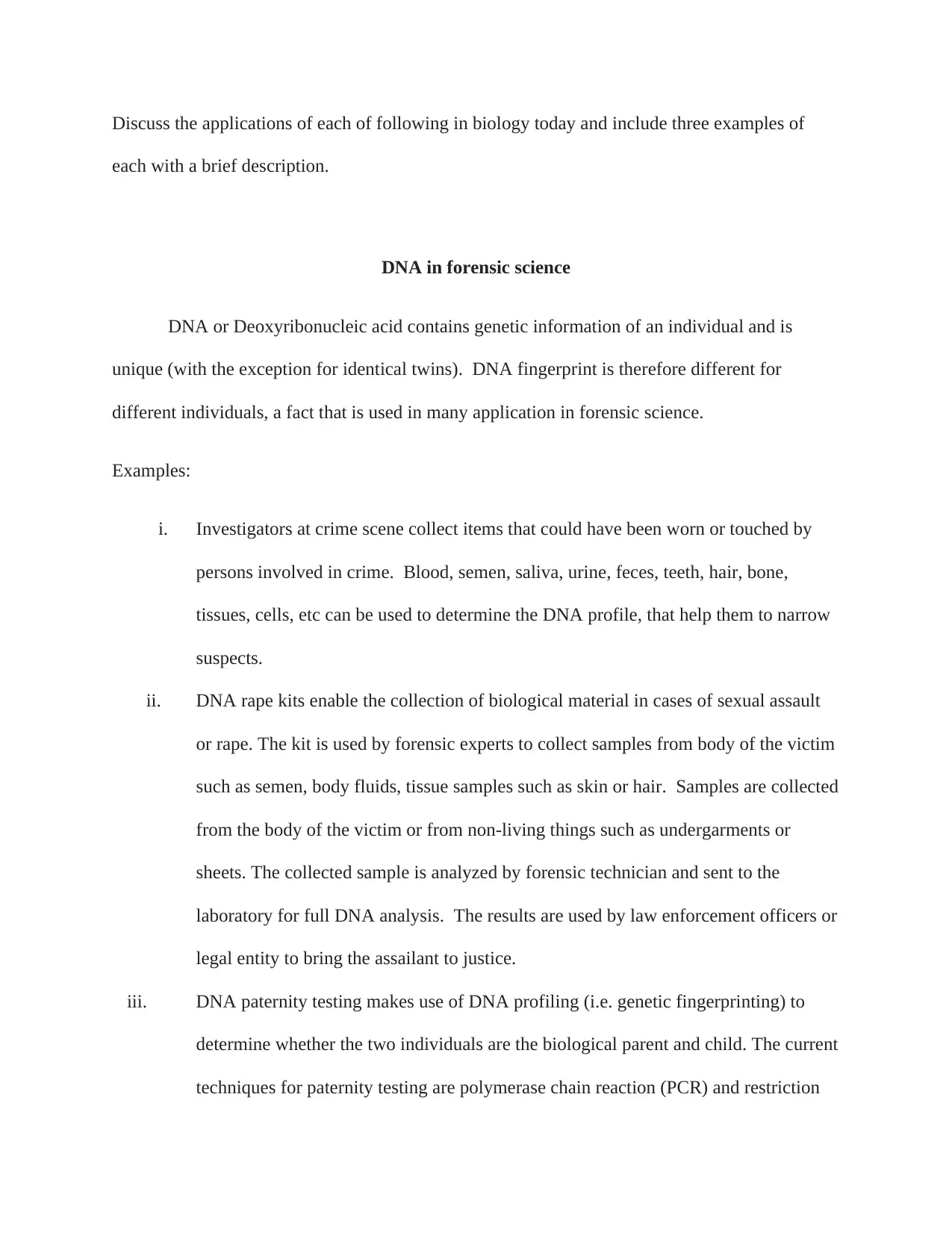
Discuss the applications of each of following in biology today and include three examples of
each with a brief description.
DNA in forensic science
DNA or Deoxyribonucleic acid contains genetic information of an individual and is
unique (with the exception for identical twins). DNA fingerprint is therefore different for
different individuals, a fact that is used in many application in forensic science.
Examples:
i. Investigators at crime scene collect items that could have been worn or touched by
persons involved in crime. Blood, semen, saliva, urine, feces, teeth, hair, bone,
tissues, cells, etc can be used to determine the DNA profile, that help them to narrow
suspects.
ii. DNA rape kits enable the collection of biological material in cases of sexual assault
or rape. The kit is used by forensic experts to collect samples from body of the victim
such as semen, body fluids, tissue samples such as skin or hair. Samples are collected
from the body of the victim or from non-living things such as undergarments or
sheets. The collected sample is analyzed by forensic technician and sent to the
laboratory for full DNA analysis. The results are used by law enforcement officers or
legal entity to bring the assailant to justice.
iii. DNA paternity testing makes use of DNA profiling (i.e. genetic fingerprinting) to
determine whether the two individuals are the biological parent and child. The current
techniques for paternity testing are polymerase chain reaction (PCR) and restriction
each with a brief description.
DNA in forensic science
DNA or Deoxyribonucleic acid contains genetic information of an individual and is
unique (with the exception for identical twins). DNA fingerprint is therefore different for
different individuals, a fact that is used in many application in forensic science.
Examples:
i. Investigators at crime scene collect items that could have been worn or touched by
persons involved in crime. Blood, semen, saliva, urine, feces, teeth, hair, bone,
tissues, cells, etc can be used to determine the DNA profile, that help them to narrow
suspects.
ii. DNA rape kits enable the collection of biological material in cases of sexual assault
or rape. The kit is used by forensic experts to collect samples from body of the victim
such as semen, body fluids, tissue samples such as skin or hair. Samples are collected
from the body of the victim or from non-living things such as undergarments or
sheets. The collected sample is analyzed by forensic technician and sent to the
laboratory for full DNA analysis. The results are used by law enforcement officers or
legal entity to bring the assailant to justice.
iii. DNA paternity testing makes use of DNA profiling (i.e. genetic fingerprinting) to
determine whether the two individuals are the biological parent and child. The current
techniques for paternity testing are polymerase chain reaction (PCR) and restriction
Paraphrase This Document
Need a fresh take? Get an instant paraphrase of this document with our AI Paraphraser
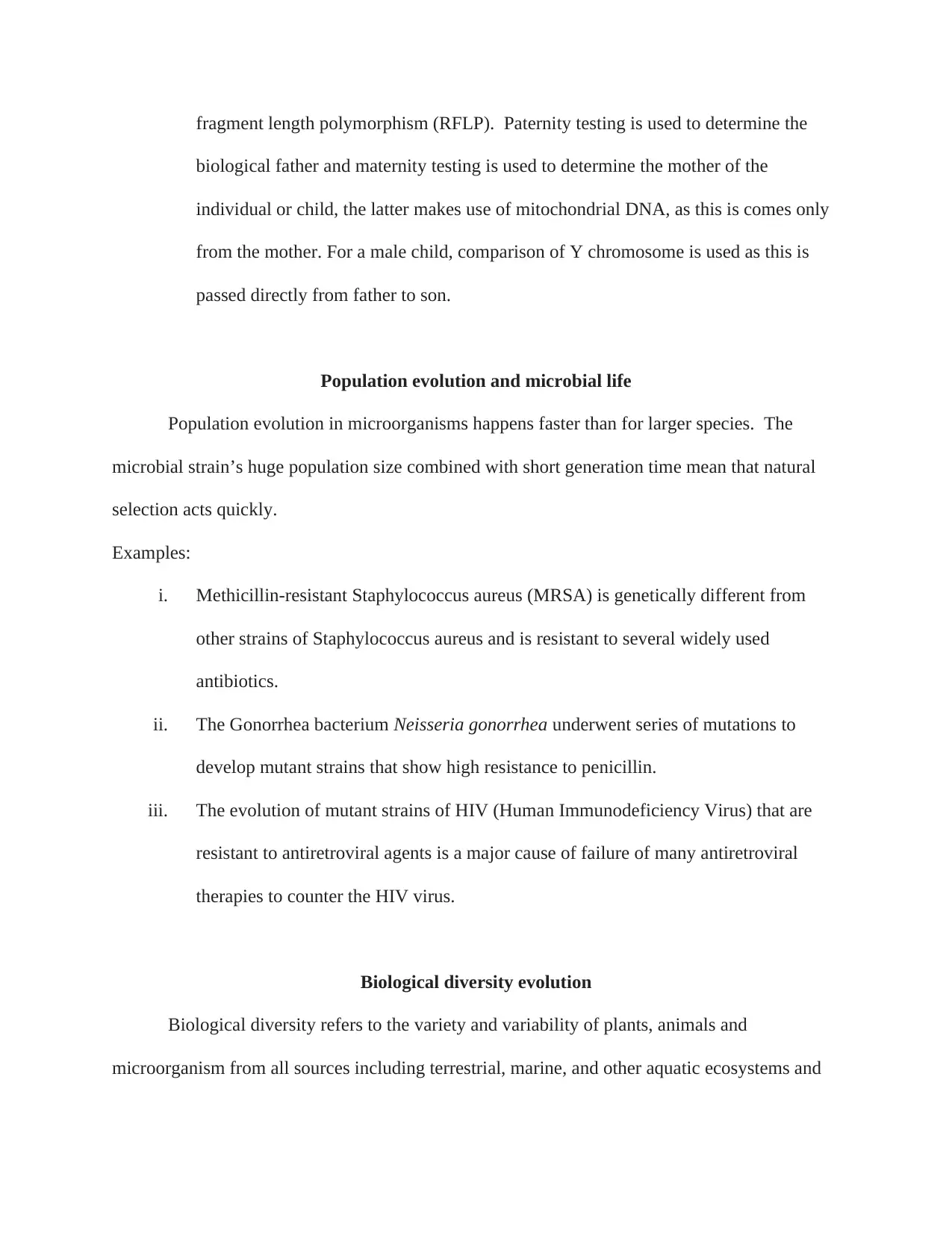
fragment length polymorphism (RFLP). Paternity testing is used to determine the
biological father and maternity testing is used to determine the mother of the
individual or child, the latter makes use of mitochondrial DNA, as this is comes only
from the mother. For a male child, comparison of Y chromosome is used as this is
passed directly from father to son.
Population evolution and microbial life
Population evolution in microorganisms happens faster than for larger species. The
microbial strain’s huge population size combined with short generation time mean that natural
selection acts quickly.
Examples:
i. Methicillin-resistant Staphylococcus aureus (MRSA) is genetically different from
other strains of Staphylococcus aureus and is resistant to several widely used
antibiotics.
ii. The Gonorrhea bacterium Neisseria gonorrhea underwent series of mutations to
develop mutant strains that show high resistance to penicillin.
iii. The evolution of mutant strains of HIV (Human Immunodeficiency Virus) that are
resistant to antiretroviral agents is a major cause of failure of many antiretroviral
therapies to counter the HIV virus.
Biological diversity evolution
Biological diversity refers to the variety and variability of plants, animals and
microorganism from all sources including terrestrial, marine, and other aquatic ecosystems and
biological father and maternity testing is used to determine the mother of the
individual or child, the latter makes use of mitochondrial DNA, as this is comes only
from the mother. For a male child, comparison of Y chromosome is used as this is
passed directly from father to son.
Population evolution and microbial life
Population evolution in microorganisms happens faster than for larger species. The
microbial strain’s huge population size combined with short generation time mean that natural
selection acts quickly.
Examples:
i. Methicillin-resistant Staphylococcus aureus (MRSA) is genetically different from
other strains of Staphylococcus aureus and is resistant to several widely used
antibiotics.
ii. The Gonorrhea bacterium Neisseria gonorrhea underwent series of mutations to
develop mutant strains that show high resistance to penicillin.
iii. The evolution of mutant strains of HIV (Human Immunodeficiency Virus) that are
resistant to antiretroviral agents is a major cause of failure of many antiretroviral
therapies to counter the HIV virus.
Biological diversity evolution
Biological diversity refers to the variety and variability of plants, animals and
microorganism from all sources including terrestrial, marine, and other aquatic ecosystems and
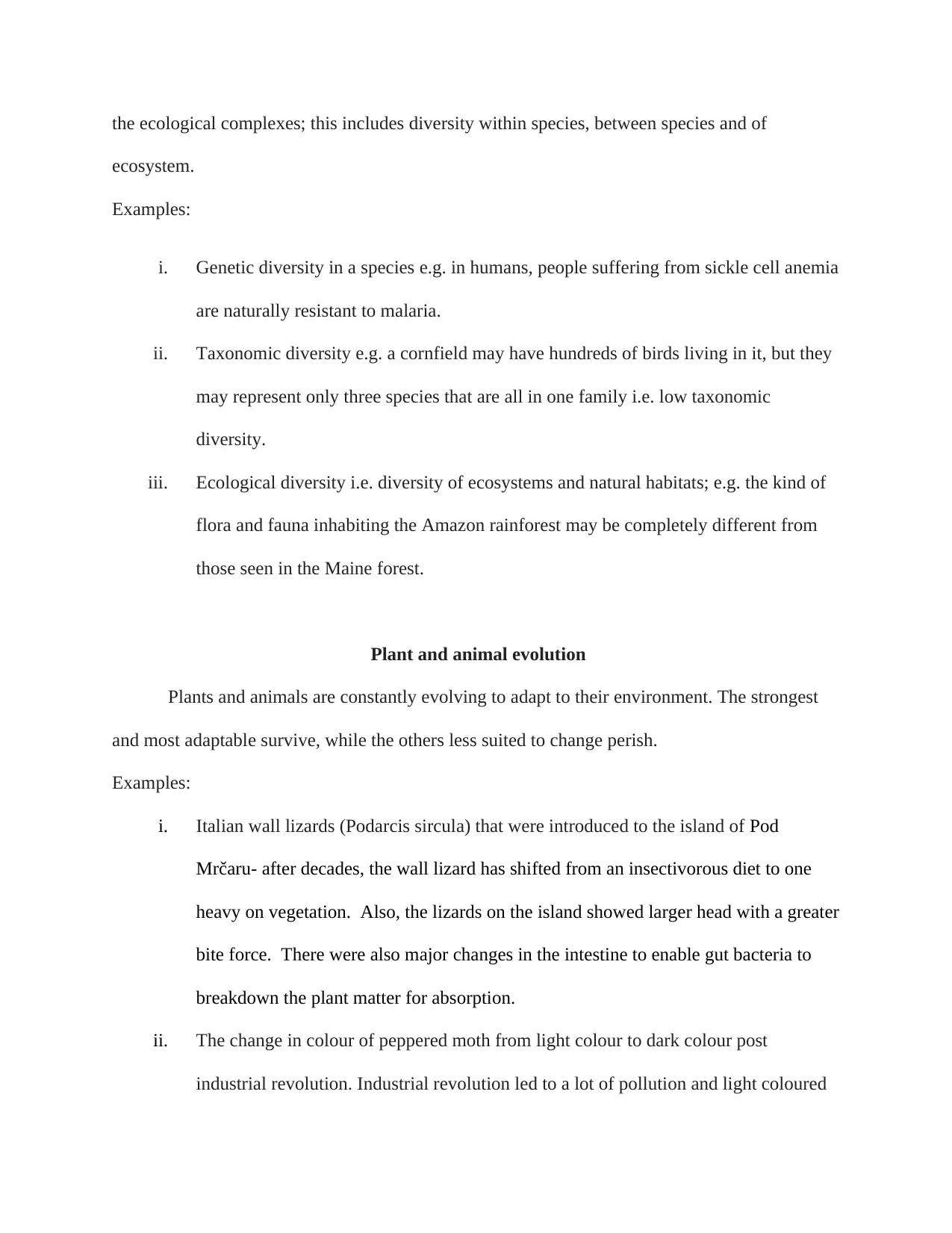
the ecological complexes; this includes diversity within species, between species and of
ecosystem.
Examples:
i. Genetic diversity in a species e.g. in humans, people suffering from sickle cell anemia
are naturally resistant to malaria.
ii. Taxonomic diversity e.g. a cornfield may have hundreds of birds living in it, but they
may represent only three species that are all in one family i.e. low taxonomic
diversity.
iii. Ecological diversity i.e. diversity of ecosystems and natural habitats; e.g. the kind of
flora and fauna inhabiting the Amazon rainforest may be completely different from
those seen in the Maine forest.
Plant and animal evolution
Plants and animals are constantly evolving to adapt to their environment. The strongest
and most adaptable survive, while the others less suited to change perish.
Examples:
i. Italian wall lizards (Podarcis sircula) that were introduced to the island of Pod
Mrčaru- after decades, the wall lizard has shifted from an insectivorous diet to one
heavy on vegetation. Also, the lizards on the island showed larger head with a greater
bite force. There were also major changes in the intestine to enable gut bacteria to
breakdown the plant matter for absorption.
ii. The change in colour of peppered moth from light colour to dark colour post
industrial revolution. Industrial revolution led to a lot of pollution and light coloured
ecosystem.
Examples:
i. Genetic diversity in a species e.g. in humans, people suffering from sickle cell anemia
are naturally resistant to malaria.
ii. Taxonomic diversity e.g. a cornfield may have hundreds of birds living in it, but they
may represent only three species that are all in one family i.e. low taxonomic
diversity.
iii. Ecological diversity i.e. diversity of ecosystems and natural habitats; e.g. the kind of
flora and fauna inhabiting the Amazon rainforest may be completely different from
those seen in the Maine forest.
Plant and animal evolution
Plants and animals are constantly evolving to adapt to their environment. The strongest
and most adaptable survive, while the others less suited to change perish.
Examples:
i. Italian wall lizards (Podarcis sircula) that were introduced to the island of Pod
Mrčaru- after decades, the wall lizard has shifted from an insectivorous diet to one
heavy on vegetation. Also, the lizards on the island showed larger head with a greater
bite force. There were also major changes in the intestine to enable gut bacteria to
breakdown the plant matter for absorption.
ii. The change in colour of peppered moth from light colour to dark colour post
industrial revolution. Industrial revolution led to a lot of pollution and light coloured
⊘ This is a preview!⊘
Do you want full access?
Subscribe today to unlock all pages.

Trusted by 1+ million students worldwide
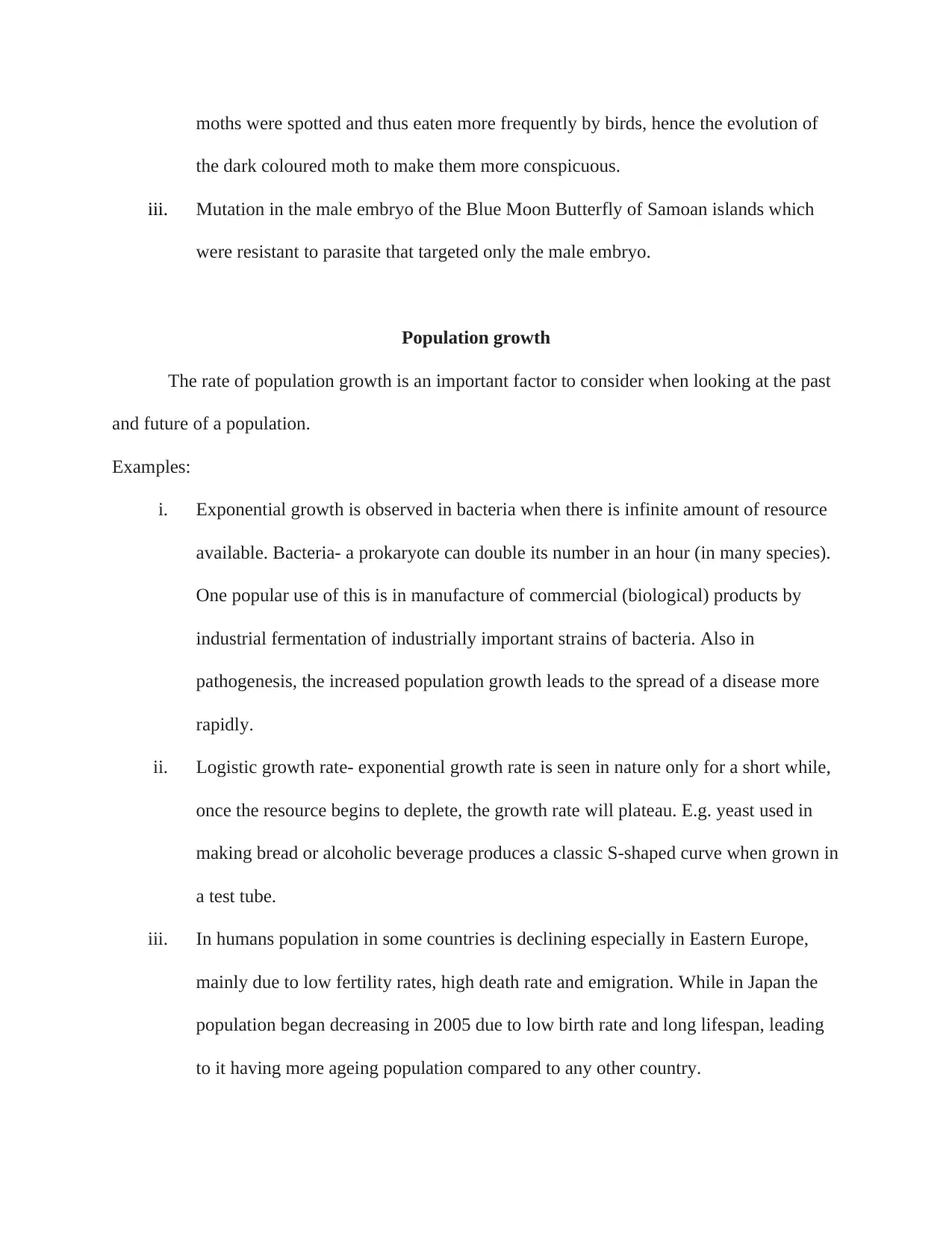
moths were spotted and thus eaten more frequently by birds, hence the evolution of
the dark coloured moth to make them more conspicuous.
iii. Mutation in the male embryo of the Blue Moon Butterfly of Samoan islands which
were resistant to parasite that targeted only the male embryo.
Population growth
The rate of population growth is an important factor to consider when looking at the past
and future of a population.
Examples:
i. Exponential growth is observed in bacteria when there is infinite amount of resource
available. Bacteria- a prokaryote can double its number in an hour (in many species).
One popular use of this is in manufacture of commercial (biological) products by
industrial fermentation of industrially important strains of bacteria. Also in
pathogenesis, the increased population growth leads to the spread of a disease more
rapidly.
ii. Logistic growth rate- exponential growth rate is seen in nature only for a short while,
once the resource begins to deplete, the growth rate will plateau. E.g. yeast used in
making bread or alcoholic beverage produces a classic S-shaped curve when grown in
a test tube.
iii. In humans population in some countries is declining especially in Eastern Europe,
mainly due to low fertility rates, high death rate and emigration. While in Japan the
population began decreasing in 2005 due to low birth rate and long lifespan, leading
to it having more ageing population compared to any other country.
the dark coloured moth to make them more conspicuous.
iii. Mutation in the male embryo of the Blue Moon Butterfly of Samoan islands which
were resistant to parasite that targeted only the male embryo.
Population growth
The rate of population growth is an important factor to consider when looking at the past
and future of a population.
Examples:
i. Exponential growth is observed in bacteria when there is infinite amount of resource
available. Bacteria- a prokaryote can double its number in an hour (in many species).
One popular use of this is in manufacture of commercial (biological) products by
industrial fermentation of industrially important strains of bacteria. Also in
pathogenesis, the increased population growth leads to the spread of a disease more
rapidly.
ii. Logistic growth rate- exponential growth rate is seen in nature only for a short while,
once the resource begins to deplete, the growth rate will plateau. E.g. yeast used in
making bread or alcoholic beverage produces a classic S-shaped curve when grown in
a test tube.
iii. In humans population in some countries is declining especially in Eastern Europe,
mainly due to low fertility rates, high death rate and emigration. While in Japan the
population began decreasing in 2005 due to low birth rate and long lifespan, leading
to it having more ageing population compared to any other country.
Paraphrase This Document
Need a fresh take? Get an instant paraphrase of this document with our AI Paraphraser
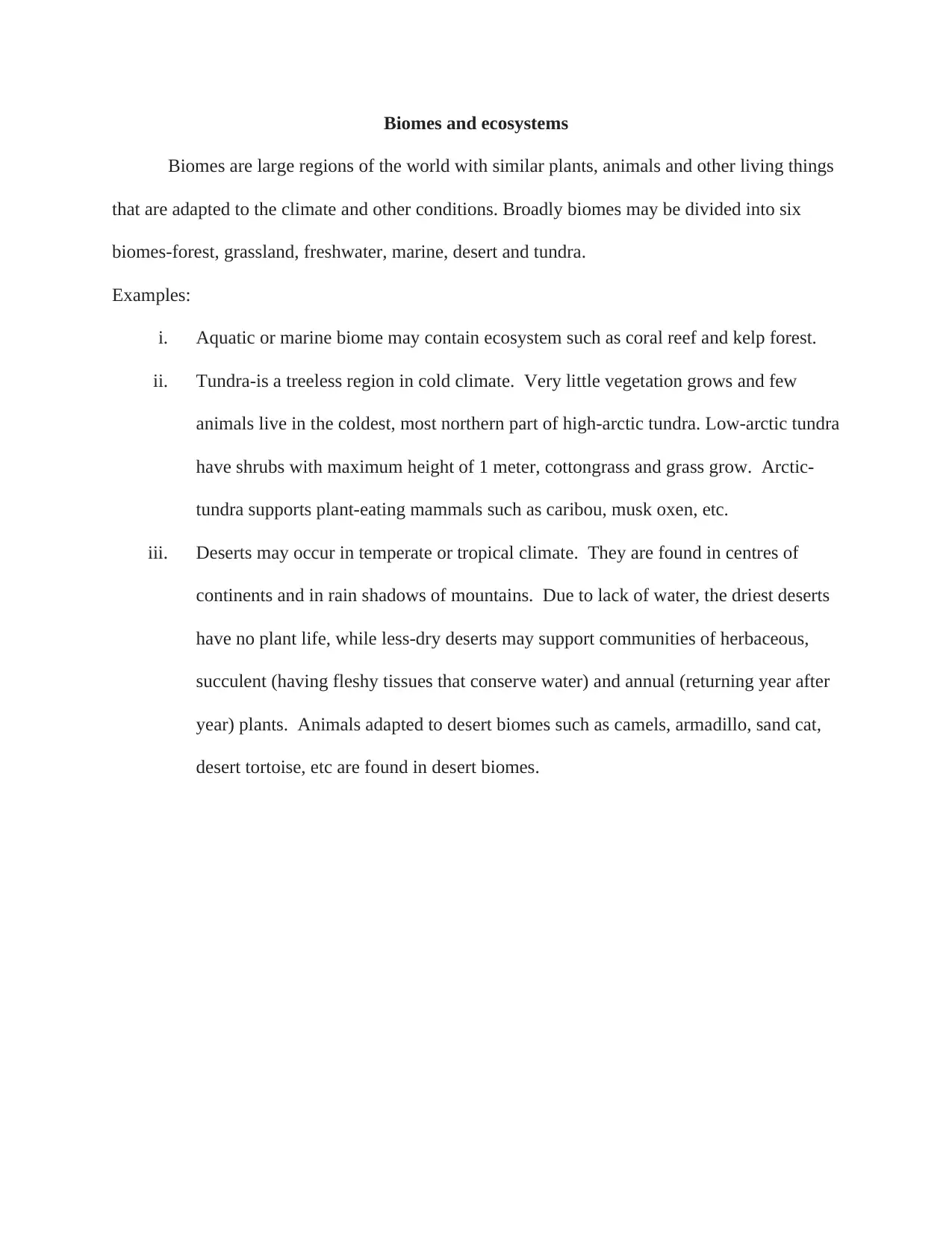
Biomes and ecosystems
Biomes are large regions of the world with similar plants, animals and other living things
that are adapted to the climate and other conditions. Broadly biomes may be divided into six
biomes-forest, grassland, freshwater, marine, desert and tundra.
Examples:
i. Aquatic or marine biome may contain ecosystem such as coral reef and kelp forest.
ii. Tundra-is a treeless region in cold climate. Very little vegetation grows and few
animals live in the coldest, most northern part of high-arctic tundra. Low-arctic tundra
have shrubs with maximum height of 1 meter, cottongrass and grass grow. Arctic-
tundra supports plant-eating mammals such as caribou, musk oxen, etc.
iii. Deserts may occur in temperate or tropical climate. They are found in centres of
continents and in rain shadows of mountains. Due to lack of water, the driest deserts
have no plant life, while less-dry deserts may support communities of herbaceous,
succulent (having fleshy tissues that conserve water) and annual (returning year after
year) plants. Animals adapted to desert biomes such as camels, armadillo, sand cat,
desert tortoise, etc are found in desert biomes.
Biomes are large regions of the world with similar plants, animals and other living things
that are adapted to the climate and other conditions. Broadly biomes may be divided into six
biomes-forest, grassland, freshwater, marine, desert and tundra.
Examples:
i. Aquatic or marine biome may contain ecosystem such as coral reef and kelp forest.
ii. Tundra-is a treeless region in cold climate. Very little vegetation grows and few
animals live in the coldest, most northern part of high-arctic tundra. Low-arctic tundra
have shrubs with maximum height of 1 meter, cottongrass and grass grow. Arctic-
tundra supports plant-eating mammals such as caribou, musk oxen, etc.
iii. Deserts may occur in temperate or tropical climate. They are found in centres of
continents and in rain shadows of mountains. Due to lack of water, the driest deserts
have no plant life, while less-dry deserts may support communities of herbaceous,
succulent (having fleshy tissues that conserve water) and annual (returning year after
year) plants. Animals adapted to desert biomes such as camels, armadillo, sand cat,
desert tortoise, etc are found in desert biomes.
1 out of 5
Your All-in-One AI-Powered Toolkit for Academic Success.
+13062052269
info@desklib.com
Available 24*7 on WhatsApp / Email
![[object Object]](/_next/static/media/star-bottom.7253800d.svg)
Unlock your academic potential
Copyright © 2020–2025 A2Z Services. All Rights Reserved. Developed and managed by ZUCOL.